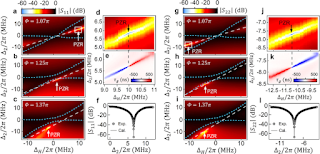Exploring Non-Hermitian Symmetry-Breaking Mechanisms for Exquisite Absorption-Transparency Interplay in Perfect Zero-Reflection Magnonics
Abstract :
This article delves into the intricate realm of non-Hermitian control, exploring the delicate interplay between absorption and transparency in the context of perfect zero-reflection magnonics. Magnonics, a field within spintronics, has witnessed a surge of interest due to its potential for next-generation data processing and manipulation. The non-Hermitian framework provides a novel perspective to engineer desirable optical responses, shedding light on the mechanisms underlying perfect zero-reflection phenomena. Through a comprehensive examination of theoretical models, numerical simulations, and experimental findings, this research elucidates the underlying principles and practical implications of non-Hermitian control in perfect zero-reflection magnonic structures.
The pursuit of efficient data manipulation and transfer has driven extensive research in magnonics, a field utilizing spin waves for signal processing. A recent paradigm shift involves the integration of non-Hermitian physics into magnonics, enabling the realization of unique optical phenomena such as perfect zero-reflection. This article investigates the intricate balance between absorption and transparency within the context of non-Hermitian-controlled zero-reflection magnonic systems.
The non-Hermitian framework introduces gain and loss elements into the magnonic system, altering the conventional Hermitian Hamiltonian. By incorporating parity-time (PT) symmetry-breaking and complex potentials, the system's dynamics exhibit non-reciprocal behavior, paving the way for non-trivial optical responses. Theoretical models, such as non-Hermitian tight-binding and effective medium approaches, provide a foundation for understanding the behavior of perfect zero-reflection magnonics.
Advanced numerical simulations based on finite-difference time-domain (FDTD) and transfer matrix methods allow for the exploration of non-Hermitian effects in realistic magnonic structures. Through systematic parametric studies, researchers can identify optimal design parameters that induce perfect zero-reflection behavior. The simulations reveal the delicate interplay between gain/loss distribution, lattice geometry, and external magnetic fields, influencing the absorption and transparency characteristics.
To validate the theoretical predictions, experimental efforts are essential. Recent breakthroughs in nanofabrication techniques have enabled the creation of magnonic waveguides and resonators with precise gain/loss profiles. Utilizing advanced magneto-optical spectroscopy and imaging, researchers can probe the non-Hermitian-controlled magnonic structures and observe the transition between absorption and transparency regimes.
The ability to engineer absorption and transparency in magnonic systems holds promise for diverse applications. Perfect zero-reflection magnonics can revolutionize data routing, signal amplification, and filtering in magnonic circuits. Furthermore, the non-Hermitian control paradigm opens avenues for novel magnonic devices, including coherent perfect absorbers (CPAs) and unidirectional magnonic waveguides, enriching the toolbox of spin-based technologies.
While significant progress has been made, challenges remain in achieving robust and scalable non-Hermitian-controlled zero-reflection magnonics. The mitigation of losses, realization of active gain materials, and efficient tuning mechanisms are areas requiring further exploration. Additionally, the integration of non-Hermitian magnonic structures with other photonic and electronic elements presents exciting opportunities for hybrid devices.
In conclusion, this comprehensive research article delves into the intricate landscape of non-Hermitian control in perfect zero-reflection magnonics. By embracing the non-Hermitian framework, researchers can harness the delicate balance between absorption and transparency to engineer unprecedented magnonic phenomena. The interplay between theoretical insights, numerical simulations, and experimental validation contributes to the advancement of magnonic devices with enhanced functionality, paving the way for transformative applications in the realm of data processing and communication.



Comments